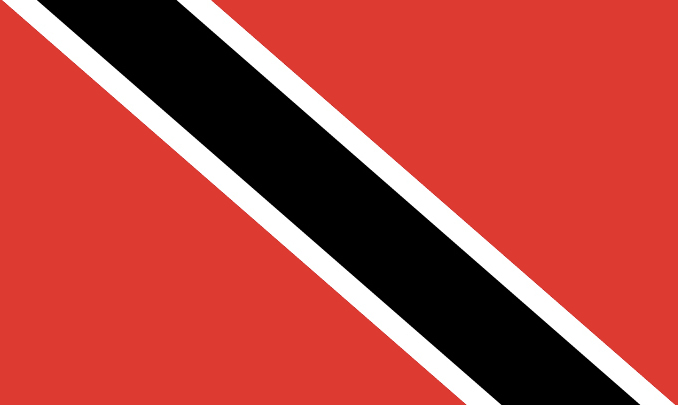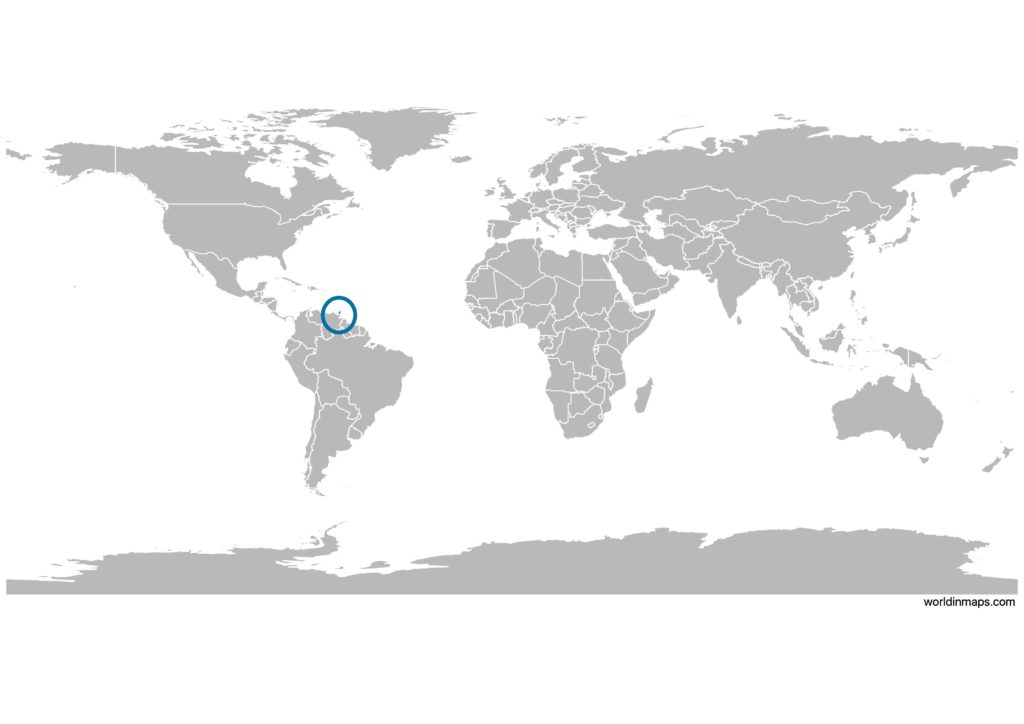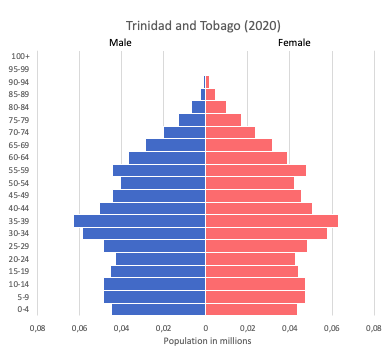Trinidad and Tobago

| Government | |
| Name | Republic of Trinidad and Tobago |
| Government type | parliamentary republic |
| Capital | Port of Spain (81,142 (2011)) |
| Currency | Trinidad and Tobago dollar (TTD) |
| Organization | |
| Member State | Commonwealth of Nations |
| People | |
| Population (2020) | 1,399,491 (156th) |
| Density of population | 264 P/km2 (54th) |
| Nationality | Trinidadian / Tobagonian |
| Official languages | |
| English | |
| Ethnic groups (2011) | |
| East Indian | 35.4% |
| African descent | 34.2% |
| mixed – other | 15.3% |
| mixed – African / East Indian | 7.7% |
| other | 1.3% |
| unspecified | 6.2% |
| Religions (2011) | |
| Protestant | 32.1% |
| Pentecostal / Evangelical / Full Gospel | 12% |
| Baptist | 6.9% |
| Anglican | 5.7% |
| Seventh-Day Adventist | 4.1% |
| Presbyterian / Congregational | 2.5% |
| other Protestant | 0.9% |
| Roman Catholic | 21.6% |
| Hindu | 18.2% |
| Muslim | 5% |
| Jehovah’s Witness | 1.5% |
| other | 8.4% |
| none | 2.2% |
| unspecified | 11.1% |
| Life expectancy (2020) | |
| Male | 70.9 years |
| Female | 76.9 years |
| Total population | 73.9 years (138th) |
| Homicides | |
| Total (2015) | 30.6 per 100,000 people (12th) |
| Geography | |
| Land area | 5,128 km2 |
| water area | 0 km2 |
| total area | 5,128 km2 (174th) |
| Mean elevation | 83 m |
| Lowest point | |
| Caribbean Sea | 0 m |
| Highest point | |
| El Cerro del Aripo | 940 m |
| Land use (2011) | |
| Agricultural land | 10.6% |
| Arable land | 4.9% |
| Permanent crops | 4.3% |
| Permanent pasture | 1.4% |
| Forest | 44% |
| Other | 45.4% |
| Urbanization | |
| Urban population (2020) | 53.2% |
| Rate of urbanization | 0.22% annual rate of change (2015 – 2020) |
| Economy | |
| Labor force (2017) | 629,400 (154th) |
| Labor force by occupation (2016) | |
| Agriculture | 3.1% |
| Industry | 11.5% |
| Services | 85.4% |
| Unemployment rate (2017) | 4.9% (72nd) |
| GDP (PPP) (estimate 2019) | |
| Total | $45.149 billion |
| Per capita | $32,684 |
| GDP (nominal) (estimate 2019) | |
| Total | $22.438 billion |
| Per capita | $16,243 |
| GDP by sector (estimate 2017) | |
| Agriculture | 0.4% |
| Industry | 47.8% |
| Services | 51.7% |
| Exports (2017) | $9.927 billion (92nd) |
| Exports partners (2017) | |
| US | 34.8% |
| Argentina | 9% |
| Imports (2017) | $6.105 billion (120th) |
| Imports partners (2017) | |
| US | 23.8% |
| Russia | 15.3% |
| Colombia | 11.1% |
| Gabon | 10.5% |
| China | 7.3% |
Trinidad and Tobago on the world map

Trinidad and Tobago top 10 largest cities (2011)
- Chaguanas (101,297)
- San Fernando (82,997)
- Port of Spain (81,142)
- Arima (65,623)
- Couva (48,858)
- Point Fortin (29,579)
- Princes Town (28,335)
- Diego Martin (25,370)
- Sangre Grande (20,630)
- Morvant (17,591)
Demography
Population pyramid

Age structure data
Estimate for 2020:
- 0-14 years: 19.01% (male 116,953/female 112,805)
- 15-24 years: 11.28% (male 70,986/female 65,389)
- 25-54 years: 43.77% (male 276,970/female 252,108)
- 55-64 years: 13.83% (male 83,650/female 83,585)
- 65 years and over: 12.11% (male 64,092/female 82,251)
Remark: the age structure of a population affects a nation’s key socioeconomic issues. Countries with young populations (high percentage under age 15) need to invest more in schools, while countries with older populations (high percentage ages 65 and over) need to invest more in the health sector. The age structure can also be used to help predict potential political issues. For example, the rapid growth of a young adult population unable to find employment can lead to unrest.
Population from 1950 to 2020
Source: United Nations, Department of Economic and Social Affairs, Population Division (2019). World Population Prospects 2019, Online Edition. Rev. 1.
Evolution of the life expectancy from 1960 to 2018
Source: World Development Indicators, The World Bank
Economy
Agriculture:
cocoa, dasheen, pumpkin, cassava, tomatoes, cucumbers, eggplant, hot pepper, pommecythere, coconut water, poultry
Industries:
petroleum and petroleum products, liquefied natural gas, methanol, ammonia, urea, steel products, beverages, food processing, cement, cotton textiles
Exports – commodities:
petroleum and petroleum products, liquefied natural gas, methanol, ammonia, urea, steel products, beverages, cereal and cereal products, cocoa, fish, preserved fruits, cosmetics, household cleaners, plastic packaging
Imports – commodities:
mineral fuels, lubricants, machinery, transportation equipment, manufactured goods, food, chemicals, live animals
Time zone and current time in Trinidad and Tobago
Go to our interactive map to get the current time in Trinidad and Tobago